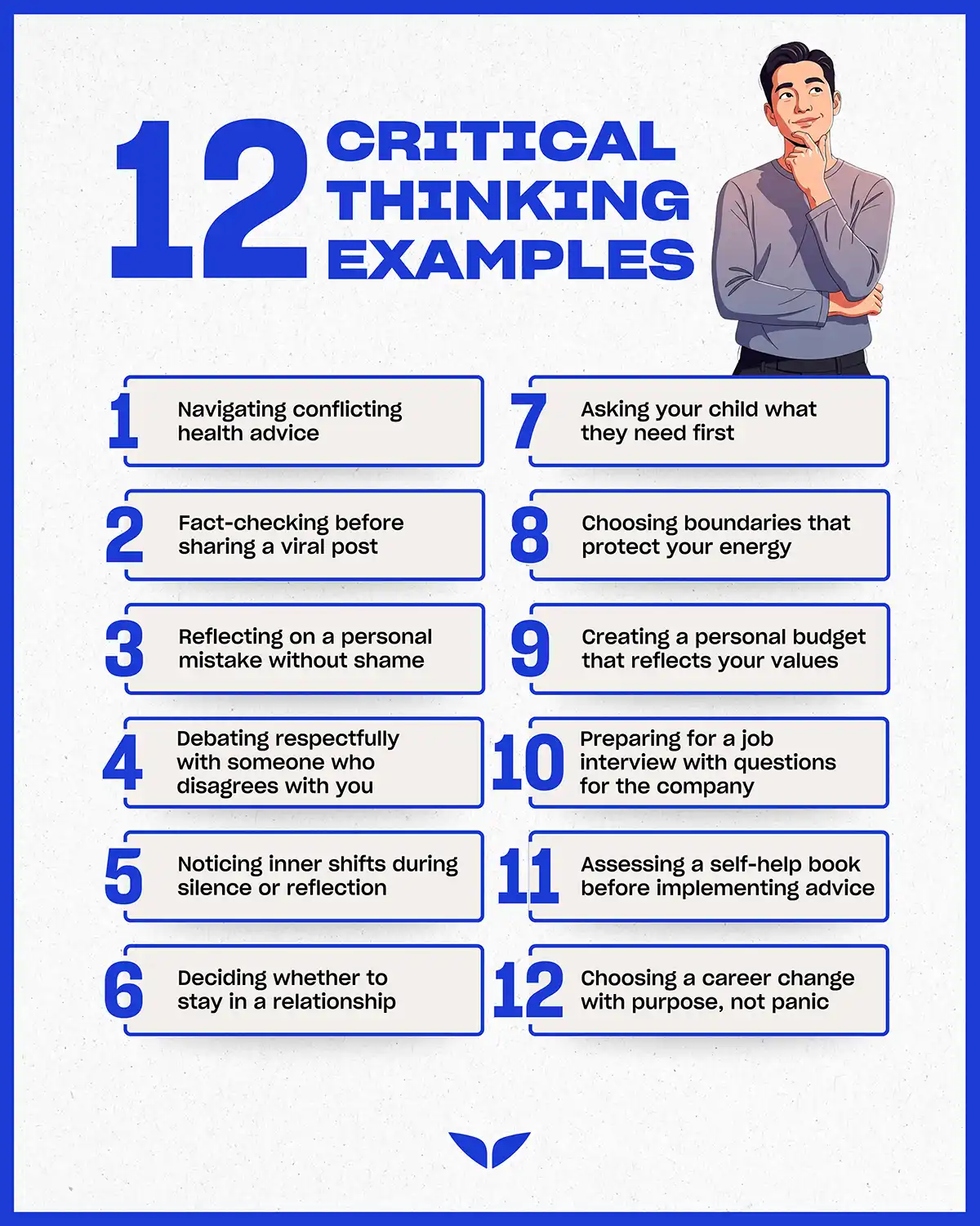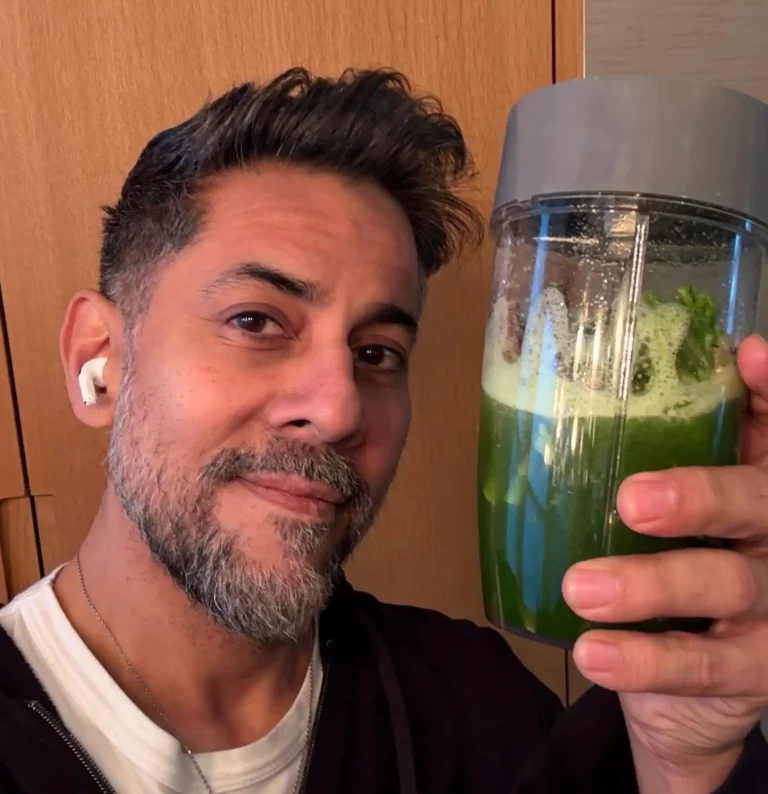There’s no shortage of critical thinking examples that unfold during the course of your day without warning.
Like, let’s say, you’re five minutes past “we were supposed to leave five minutes ago!” and your toddler’s nervous system picks that exact moment for a meltdown. What do you do?
Or you’re heading home from work, and the traffic greets you immediately. What do you do?
Or a close friend tells you that they have cancer. What do you do?
That’s the beauty of critical thinking. It shifts your mind from automatic mode to intentional action in the face of scenarios like these.
As brain performance expert Jim Kwik says in his Superbrain program on Mindvalley, “All behavior is belief-driven.” And when you’re able to see the moment where choice appears, that becomes the space where growth begins.
12 critical thinking examples you’ll want to start using today
So you have the toddler tantrum, the traffic slowdown, and the friend sharing hard news. But you might wonder, “What are critical thinking examples I’d actually use in my everyday life?”
The truth is, they’re far more familiar than you think.
1. Navigating conflicting health advice
Like it or not, there’s conflicting health advice everywhere. One could be telling you that celery juice can save your life. Another insists you need a twelve-step memory supplement routine before sunrise.
A big chunk of this shows up on social media. And research shows that over half of adults use that medium for health advice, yet fewer than half trust most of what they see.
Your mind’s trying to make sense of it all because your overall well-being deserves decisions shaped by clarity, not noise. So…hello, critical thinking.
The mental skill at play here is evaluation. You…
- Slow the rush of opinions and study the information in front of you.
- Notice which claims rely on evidence and which rely on volume.
- Check whether the source has real expertise or a clever headline.
- Separate personal anecdotes from actual research.
- Consider how the guidance fits your history, goals, and lifestyle.
With this, you’re able to choose with intention. You start to see that health choices become easier when you treat them like a conversation with your future self.
2. Fact-checking before sharing a viral post
Viral posts are viral for a reason. One second, it’s just thoughtless rambling. The next second, it’s everywhere and being analyzed years later.
Remember #COVFEFE, anybody? It was about absolutely nothing. Research, though, shows your mind gets pulled in because everyone’s making a big deal out of it.
Critical thinking here makes a big difference. You…
- Read the entire post instead of the screenshot.
- Search for the original source.
- Check the date and the context.
- Notice whether the message tries to stir emotion instead of offering information.
- Pause long enough to see if the claim matches everyday reality.
All of this is intentional. And when you do so, you bring clarity into conversations that often move too fast. Plus, you show your community that your shares come from care, not impulse.
3. Reflecting on a personal mistake without shame
Chances are, at least once in your life, you’ve jumped straight into the deep end of self-judgment. The guilt, the overthinking, and wishing you had handled the situation differently.
Do you remember that scene in Season 1 of Ted Lasso when Ted snaps at Nate for trying to slip his coaching notes under Ted’s hotel-room door? Ted, under the personal stress of divorce papers, anxiety, and a big match ahead, loses his calm and snaps at Nate to leave. “Go! Get outta here!”
This is one of those examples of critical thinking that shows how a pause gives the mind a calm space to review the situation without spiraling. A few things you, yourself, can do include:
- Writing down the moment that felt messy.
- Identifying the part you can influence.
- Noting the emotion that shaped your first reaction.
- Looking for the lesson that appears once the feeling settles.
- Choosing one small adjustment that supports your next step.
Each insight adds a layer of self-awareness. You grow through the moment instead of carrying it as a personal weight, and start to trust your own ability to learn from real life.
As for Ted, taking time to pause and reflect gave him the space to understand what he did wrong. And he apologizes to Nate for it: “I bit your head off for no good reason, and I’m really sorry about that, and I hope you can forgive me.”
4. Debating respectfully with someone who disagrees with you
Every interaction you have is susceptible to disagreements. It’s just the nature of being human.
The thing is, evolution trained the brain to protect you during moments of conflict. So your mind will want to put its most determined soldier at the frontline: the ego.
But a few simple habits can help you stay grounded when things get tense:
- Ask a clarifying question before responding.
- Repeat the part you understood so both sides feel anchored.
- Notice your tone and steady it before the next sentence.
- Study the point being made rather than the emotion behind it.
- Share your view with calm language that invites dialogue.
You see the same thing in many critical thinking examples for students. Class debates, group projects, and late-night study sessions all train the mind to stay curious instead of reactive.
The goal here isn’t to win the war. Rather, it’s to find a peaceful solution that turns the conversation into something more constructive and respectful.
5. Noticing inner shifts during silence or reflection
Who are we kidding? This world is noisy.
If it’s not the hustle and bustle of face-to-face interactions, it’s the hustle and bustle of digital interactions. There’s not a moment when the world is just quiet.
But have you ever taken a minute to sit with your thoughts? What comes up for you?
Granted, it’s no easy feat. Jim’s student, Nelly Bos, a legal assistant from the Netherlands, knows this well. On Mindvalley Stories, she shares how unaware she was that her thoughts and spirit were chaotic. “I felt uneasy and worried, but was not fully aware of what was wrong.”
Unprocessed emotions and unfinished thoughts can feel tangled. Plus, your brain is wired to seek stimulation, and digital devices hijack attention.
But there are plenty of benefits to sitting with your thoughts. Research shows that reflection and self‐awareness significantly boost clarity, emotional regulation, and decision-making.
And when it becomes a habit, you can start to understand yourself with more accuracy.
6. Deciding whether to stay in a relationship
If examples of critical thinking skills include reading the room and asking questions that actually reveal something, it definitely can be useful in relationships, too.
For instance, say you tense up every time your partner mentions the future. That’s the tiny critical thinking cue to pause and ask yourself what you truly want out of the union.
Two people coming is a beautiful thing, yes. The thing we often forget, though, is that history, emotion, habits, and hopes all sit at the same table. So to cut through the noise, you can do a few things:
- Notice what triggered the shift in the relationship.
- Name the feeling that rises first.
- Review the patterns that keep repeating.
- Ask yourself what you need in order to feel safe and supported.
- Check whether the relationship can realistically hold that need.
“Conscious awareness is the first part of solving a problem,” says Jim. So approach them with a calm mind and a grounded sense of self.
7. Asking your child what they need first
If you have children, you know that parenting them can feel like trying to read a book with half the pages missing. One moment, everything seems fine. The next moment, the bedroom door closes with Olympic-level force, and you have no idea what story you just walked into.
Before you respond with a similar Olympic-level force, ask yourself what are examples of critical thinking that you can take inspiration from.
Like, in Turning Red, there’s a scene where Mei is overwhelmed after school, and Ming can tell something shifted. Instead of lecturing, Ming kneels beside her, studies her face, and asks what is happening inside her.
Similarly, in Boyhood, Mason Sr. notices his son pulling back during their camping trip.
Instead of hounding Mason, he asks what has been on his mind and does some active listening.
Take note and try it yourself:
- Ask what support would feel helpful right now.
- Listen without jumping to a conclusion.
- Notice the emotion behind their first response.
- Clarify what part they want you to be involved in.
- Check in again once the moment settles.
That kind of conscious parenting creates a safer space at home. It also teaches your children how to pause, communicate, and think with more intention.
8. Choosing boundaries that protect your energy
Do you have a friend who treats your time like an endless help hotline? When the phone lights up, your stomach sinks, and you already know the conversation will drain you.
Or you might notice that your body gets tense every time a family member asks for “one more thing.” Or that moment when your coworker swings by with “a tiny favor” that eats half your afternoon.
Boundaries, friend. Learn how to set up boundaries.
“The biggest travesty in the world,” says Jim, “is people preventing and limiting themselves from expressing who they really are because they’re afraid of what other people think.”
The thing is, though, you’re wired to be a people pleaser. Research shows you, as a human, carry a deep need to belong, and that need makes social approval feel essential.
Unfortunately, that also opens the door to a request here, a favor there, and another tiny “sure, no problem” squeezed into your already-overflowing calendar.
The good news is, a few critical thinking moves can help you protect the energy you may be giving away:
- Notice the moment your energy dips around a person or situation.
- Name the feeling that shows up when your schedule gets crowded.
- Review your commitments and highlight the ones that feel heavy.
- Ask yourself what limit would support your well-being.
- Share that limit with calm, clear language.
“You do not have to try and make everyone happy,” Jim advises. “Remember to take time for you, time to replenish.”
9. Creating a personal budget that reflects your values
You open your phone and make a beeline for the shopping app. It’s so automatic now that you do it without thinking. You convince yourself you need a new water bottle even though you already own seven.
Critical thinking says, “Do you need it? Or do you want it?”
You might not realize it, yet this is one of the most practical critical thinking skills examples you can use in adult life. Those tiny questions pull you out of impulse mode and drop you into financial freedom-type awareness.
From here, the work gets simple:
- Notice where your money flows without your permission.
- Circle the purchases that actually add something meaningful to your life.
- Cross out the ones that came from impulse or stress.
- Ask what kind of life you want your money to support.
- Set one small rule that honors that intention.
Once you see your spending with that level of honesty, you get to choose the life you build with it.
10. Preparing for a job interview with questions for the company
In The Intern, Ben asks Jules what she truly needs in the position, what support matters, and how she wants the workflow handled. Granted, he’s seasoned, but it’s one of the quintessential examples of critical thinking in the workplace.
Think of it this way: every question you ask gives you a peek behind the curtain of the company you might spend forty hours a week with. You could ask:
- “What does success look like in this role during the first three months?”
- “How does your team handle feedback and collaboration?”
- “What qualities matter most in the people who thrive here?”
- “How does the company support learning and growth?”
- “What do you enjoy most about working here?”
Bonus to all this? These types of questions, as research shows, can help you decide whether this is a job that aligns with your values and your direction. That is the real power move.
11. Assessing a self-help book before implementing advice
Remember when Eat, Pray, Love came out and everybody started going to Bali and getting Ketut to realign their lives? It might’ve been something Elizabeth Gilbert needed at that point in her life. But not every idea in a book is meant for your mind, your lifestyle, or your actual goals.
Some advice works beautifully. Some advice belongs in the “cute but no thank you” pile. And some advice looks powerful until you try it and realize it was written by someone who has a private chef, a meditation dome, and zero children.
So before you overhaul your entire life and move halfway around the world to meditate in an ashram in India, do a quick reality check:
- Check who the author is and what their expertise actually covers.
- Notice whether the advice aligns with your values or just sounds impressive.
- Ask whether the recommendation fits your current season of life.
- Look for evidence, research, or lived experience behind the claim.
- Try one tiny step first instead of changing everything overnight.
This small moment of discernment saves you from burnout, confusion, and unrealistic expectations. And the best part is, you end up choosing the kind of advice that genuinely supports you, not the kind that just looks good on a bookshelf.
12. Choosing a career change with purpose, not panic
Jose Franceschini, one of Jim’s students from Puerto Rico, loves his work, teaching students as the chair of the department of psychiatry at a medical school in his home country. “My goal is to be as active as I can until at least 80 years,” says the 70+-year-old.
No doubt, finding something fulfilling and making that career change can be overwhelming. But, as Jim asks, “How will you serve the world? What do they need that your talent can provide? That’s all you have to figure out.”
Easier said than done, for sure. But more intentional than drifting, definitely.
So put on your critical thinking cap, and start here:
- Notice which parts of your work still give you life.
- Name the tasks that drain you faster than a bad Wi-Fi connection.
- Review the skills you want to use more often.
- Ask what kind of future would actually excite you.
- Create one tiny step that moves you in that direction.
A grounded decision grows from honest reflection, not from panic-quitting on a Tuesday afternoon. You study your patterns, study your needs, and study your direction until you’re like Jose.

Why critical thinking matters more now than ever
Critical thinking, according to psychologist and award-winning educator Diane Halpern, is the mental process you use when you face a problem, make a decision, choose whom to trust, or figure out your next move.
That seems pretty straightforward at face value. But information today hits your brain with the speed of a firehose.
“The pursuit of information has become so all-consuming that many people find that they are constantly multitasking,” writes Diane in her book, Thought and Knowledge: An Introduction to Critical Thinking.
In fact, research shows information overload weakens decision-making, making it harder for the brain to separate signal from noise.
And that’s before you add AI into the mix. This technology can sharpen your thinking when you use it to explore ideas, compare sources, and ask smarter questions. But it also dulls your thinking when you take every output as truth and skip the fact-checking.
Then, there’s doomscrolling, with emotional headlines, outrage loops, and algorithm-driven content pulling your attention in every direction. One swipe turns into 20. Twenty turns into a full hour. Soon enough, brain rot ensues.
“If we cannot think intelligently about the myriad of issues that confront us, then we are in danger of having all of the answers, but still not knowing what they mean,” Diane explains.
This is why critical thinking matters more than ever.
This skill helps you study the source, spot the emotional hook, and ask what the information is trying to make you feel. You pause long enough to see if it matches your reality.
Diane adds that the real power comes from two things: learning how to learn and thinking clearly as information explodes around you. And awareness like this turns the modern world from a mental overload into something you can navigate with clarity, direction, and confidence.
How to practice critical thinking (even on busy days)
If only real-life examples of critical thinking came with a neon sign that flashed, “Hey, pay attention, this part matters.”
But it rarely gives you that. What it does give you is rush-hour traffic, overflowing inboxes, half-finished lunches, and the constant hum of “I’ll deal with it later.”
“It is difficult to imagine any area where the ability to think clearly is not needed,” Diane points out. “Yet, few of us have ever received explicit instructions in how to improve the way we think.”
It’s assumed that as people transition into adulthood, they automatically know how to think. Clearly, with all the critical thinking examples listed, plus countless others, that’s not the case.
Conscious awareness is the first part of solving a problem.
— Jim Kwik, trainer of Mindvalley’s Superbrain program
There are practical ways to strengthen your thinking without adding anything overwhelming to your day. Here are a few simple suggestions to start you off:
1. Ask thought-provoking questions
“The questions we ask play a very pivotal role in shaping our reality,” says Jim. And a single question can change the entire direction of your thinking.
“When we ask ourselves something specific, our brain works to find answers,” he adds. “It concentrates on the elements related to that question.”
Like the “Do you want it? Or do you need it?” when contemplating your shopping impulses interrupts autopilot and forces your mind to scan the moment with fresh eyes.
The great thing about it is that you can do this anywhere—in a meeting, in traffic, or even in the kitchen while you’re reheating leftovers for the third day in a row.
To start, try thought-provoking questions like:
- What is the real issue here?
- What matters most in this moment?
- What evidence am I working with?
- What choice supports my goals?
- What outcome do I want?
Questions like these give you clarity you cannot get from reacting. They put your mind in study mode instead of survival mode. And the more you use them, the more natural it becomes to think with accuracy, not urgency.
2. Slow your roll
Busy days pull your brain in a hundred directions at once. A text arrives, a request pops up, or someone wants an answer right now.
But your brain, at least according to Jim, can’t stay in a constant state of output. Slowing down or taking a second to pause gives your mind room to settle.
Here are a few ways how:
- Take one calm breath before you reply.
- Say, “Let me think for a second.”
- Grab a sip of water.
- Look away from the screen for a moment.
- Go outside and do earthing.
These tiny moves pull you out of urgency and reconnect you with your thinking mind.
3. Read books
The brain loves depth, yet 21st-century life rarely gives you enough of it. Reading brings it back.
“If you read 100 pages or more,” says Kristina Mӓnd-Lakhiani in her Mindvalley U stage talk, “that actually is crucial for your critical thinking.”
The co-founder of Mindvalley and host of the Mindvalley Book Club goes on to explain that long-form reading (read: actual books, not subtitles on your favorite Netflix show or closed captions on Instagram posts) “actually activates other parts of your brain and is very beneficial for you in many ways.”
Research shows that it helps…
- Stretch your attention span;
- Strengthen your ability to follow an idea, question it, and study it from multiple angles; and
- Train your mind to stay with a thought longer than a headline, a scroll, or a three-second clip.
“Reading,” says Jim, “is downloading decades of information to your brain in a few hours.” So pick books that teach you something your future self might thank you for.
Choose topics that pull you forward. Leadership, psychology, creativity, health, human behavior, or, really, any personal development books that expands your understanding of the world.
But don’t think you have to do it in one sitting. Reading in short bursts works fine, like 10 minutes before bed, a page while you wait in line, or a chapter on a quiet Sunday. Every minute strengthens your ability to think clearly.
Unleash your limitless
Chances are, you’ve had days when your brain feels tired even before the day begins. You read the same line twice or forget things you swear you should remember.
Thanks to the way life keeps crowding your headspace, your mind is overwhelmed. And it deserves better tools.
That is why Jim Kwik, in collaboration with Mindvalley, created Superbrain. Inside this powerful brain-training program, he shows you how to…
- Wake your mind up again;
- Remember names with confidence;
- Learn faster without pressure;
- Feel mentally present instead of mentally pulled in every direction; and
- Strengthen your focus so you stay with what matters
By the end, you may feel something you have not felt in a while: trust in your own mind. That is what Daniel Ford, an author from the U.S., found. He shares:
Thanks to this program, I discovered that my brain is malleable and capable of transformation… I learned how to unlock new ways of thinking, retain knowledge effectively, and apply these skills to solve real-life challenges.
That kind of trust makes you believe you can keep up with your life, your goals, and your potential. And you can get a taste of what is possible in Mindvalley’s free Superbrain masterclass, a prelude to the main program.
The fact of the matter is, your brain carries you through everything. Give it the care it deserves.
Welcome in.










